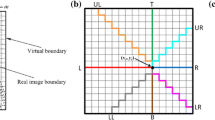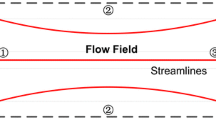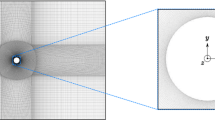Abstract
The post-processing of the measured velocity in particle image velocimetry (PIV) is a critical step in reducing error and predicting missing information of the flow field. In this work, time-resolved PIV data are incorporated with the incompressible Navier–Stokes (N–S) equations to reduce the measurement error and improve the accuracy. A pressure correction scheme (PCS) based on the projection method is adopted to solve the N–S equations, and an optimization algorithm is introduced to balance the fidelity between the PIV data and the numerical solutions. The PCS for PIV data, called PIV–PCS, cannot only reduce the errors in the velocity divergence and the curl of the pressure gradient but also ensure that the flow field satisfies the dynamic constraints imposed by the momentum equation. An important weight coefficient s that balances the level of the velocity modification with the residual of the governing equation is defined and numerically assessed. A method for optimizing the value of s is provided. The new approach is evaluated by two time-resolved PIV experiments: one on the 2D wake flow of a circular cylinder at low Reynolds number and one on tomographic PIV for the 3D wake flow of a hemisphere at high Reynolds number. All the numerical assessments and experimental applications are compared with the divergence-free smoothing (DFS) method. The results indicate that the presented PIV–PCS method is superior to the DFS method in terms of reducing the measurement error and recovering the real physical flow structures.














Similar content being viewed by others
References
Acarlar MS, Smith CR (1987a) A study of hairpin vortices in a laminar boundary-layer. 1. Hairpin vortices generated by a hemisphere protuberance. J Fluid Mech 175:1–41. https://doi.org/10.1017/s0022112087000272
Acarlar MS, Smith CR (1987b) A study of hairpin vortices in a laminar boundary-layer. 2. Hairpin vortices generated by fluid injection. J Fluid Mech 175:43–83. https://doi.org/10.1017/s0022112087000284
Adrian RJ (2007) Hairpin vortex organization in wall turbulence. Phys Fluids 19(041):301
Adrian RJ, Meinhart CD, Tomkins CD (2000) Vortex organization in the outer region of the turbulent boundary layer. J Fluid Mech 422:1–54
Andrea S, Bernhard W (2016) PIV uncertainty propagation. Meas Sci Technol 27(8):084006
Azijli I, Dwight RP (2015) Solenoidal filtering of volumetric velocity measurements using gaussian process regression. Exp Fluids 56(11):198. https://doi.org/10.1007/s00348-015-2067-7
Chorin A (1968) Numerical solution of the Navier–Stokes equations. Math Comput 22:745–762
de Kat R, van Oudheusden BW (2012) Instantaneous planar pressure determination from PIV in turbulent flow. Exp Fluids 52(5):1089–1106. https://doi.org/10.1007/s00348-011-1237-5
de Silva C, Philip J, Marusic I (2013) Minimization of divergence error in volumetric velocity measurements and implications for turbulence statistics. Exp Fluids 54(7):1–17. https://doi.org/10.1007/s00348-013-1557-8
Elsinga GE, Scarano F, Wieneke B, van Oudheusden BW (2006) Tomographic particle image velocimetry. Exp Fluids 41:933–947
Ganapathisubramani B, Longmire EK, Marusic I, Pothos S (2005) Dual-plane PIV technique to measure complete velocity gradient tensor in a turbulent boundary layer. Exp Fluids 39:222–231
Ganapathisubramani B, Longmire EK, Marusic I (2006) Experimental investigation of vortex properties in a turbulent boundary layer. Phys Fluids 18(055):105
Garcia D (2010) Robust smoothing of gridded data in one and higher dimensions with missing values. Comput Stat Data Anal 54(4):1167–1178. https://doi.org/10.1016/j.csda.2009.09.020
Garcia D (2011) A fast all-in-one method for automated post-processing of PIV data. Exp Fluids 50:1247–1259
Gesemann S, Huhn F, Schanz D, Schrder A (2016) From noisy particle tracks to velocity, acceleration and pressure fields using B-splines and penalties. In: International symposium on applications of laser techniques to fluid mechanics
Guermond JL, Minev P, Shen J (2006) An overview of projection methods for incompressible flows. Comput Methods Appl Mech Eng 195(44C47):6011–6045. https://doi.org/10.1016/j.cma.2005.10.010
Gunes H, Rist U (2007) Spatial resolution enhancement/smoothing of stereo-particle-image-velocimetry data using proper-orthogonal-decompositionlbased and Kriging interpolation methods. Phys Fluids 19:064101–064119
Higham JE, Brevis W, Keylock CJ (2016) A rapid non-iterative proper orthogonal decomposition based outlier detection and correction for PIV data. Meas Sci Technol 27(12):125303. https://doi.org/10.1088/0957-0233/27/12/125303
John JC, Cameron VK, Barton LS, Pavlos PV (2010) Assessment of pressure field calculations from particle image velocimetry measurements. Meas Sci Technol 21(10):105401. https://doi.org/10.1088/0957-0233/21/10/105401
Liu XF, Katz J (2006) Instantaneous pressure and material acceleration measurements using a four-exposure PIV system. Exp Fluids 41(2):227. https://doi.org/10.1007/s00348-006-0152-7
Lynch KP, Scarano F (2015) An efficient and accurate approach to MTE-MART for time-resolved tomographic PIV. Exp Fluids 56(3):1–16
Lynch K, Prbsting S, Scarano F (2014) Temporal resolution of time-resolved tomographic PIV in turbulent boundary layers. In: 17th international symposium on applications of laser techniques to fluid mechanics
McClure J, Yarusevych S (2017) Optimization of planar PIV-based pressure estimates in laminar and turbulent wakes. Exp Fluids 58(5):62. https://doi.org/10.1007/s00348-017-2337-7
Novara M, Scarano F (2012) Performances of motion tracking enhanced Tomo-PIV on turbulent shear flows. Exp Fluids 52(4):1027–1041
Novara M, Batenburg KJ, Scarano F (2010) Motion tracking-enhanced MART for tomographic PIV. Meas Sci Technol 21(3):18. https://doi.org/10.1088/0957-0233/21/3/035401
Okuno T, Sugii Y, Nishio S (2000) Image measurement of flow field using physics-based dynamic model. Meas Sci Technol 11(6):667–676. https://doi.org/10.1088/0957-0233/11/6/309
Oudheusden BWV (2013) PIV-based pressure measurement. Meas Sci Technol 24(3):032001. https://doi.org/10.1088/0957-0233/24/3/032001
Pan Z, Whitehead J, Thomson S, Truscott T (2016) Error propagation dynamics of PIV-based pressure field calculations: how well does the pressure poisson solver perform inherently? Meas Sci Technol 27(8):084012. https://doi.org/10.1088/0957-0233/27/8/084012
Raffel M (2007) Particle image velocimetry: a practical guide, 2nd edn. Springer, New York
Scarano F (2002) Iterative image deformation methods in PIV. Meas Sci Technol 13(1):R1–R19
Schneiders JFG, Scarano F (2016) Dense velocity reconstruction from tomographic PTV with material derivatives. Exp Fluids 57(9):1–22. https://doi.org/10.1007/s00348-016-2225-6
Schanz D, Schröder A, Gesemann S (2014) ’Shake The Box’—a 4D PTV algorithm: accurate and ghostless reconstruction of Lagrangian tracks in densely seeded flows. In: 17th international symposium on applications of laser techniques to fluid mechanics
Schanz D, Gesemann S, Schrder A (2016) Shake-the-box: Lagrangian particle tracking at high particle image densities. Exp Fluids 57(5):1–27. https://doi.org/10.1007/s00348-016-2157-1
Schneiders JG, Dwight R, Scarano F (2014) Time-supersampling of 3D-PIV measurements with vortex-in-cell simulation. Exp Fluids 55(3):1–15. https://doi.org/10.1007/s00348-014-1692-x
Schneiders JFG, Dwight RP, Scarano F (2015) Tomographic PIV noise reduction by simulating repeated measurements. In: International symposium on particle image velocimetry
Sciacchitano A, Dwight R, Scarano F (2012a) Navier–Stokes simulations in gappy PIV data. Exp Fluids 53(5):1421–1435. https://doi.org/10.1007/s00348-012-1366-5
Sciacchitano A, Scarano F, Wieneke B (2012b) Multi-frame pyramid correlation for time-resolved PIV. Exp Fluids 53(4):1087–1105. https://doi.org/10.1007/s00348-012-1345-x
Smits AJ, McKeon BJ, Marusic I (2011) High-Reynolds number wall turbulence. Ann Rev Fluid Mech 43(1):353–375. https://doi.org/10.1146/annurev-fluid-122109-160753
Strang G (2007) Computational science and engineering. Wellesley-Cambridge Press, Wellesley
Suzuki T (2012) Reduced-order Kalman-filtered hybrid simulation combining particle tracking velocimetry and direct numerical simulation. J Fluid Mech 709:249–288. https://doi.org/10.1017/jfm.2012.334
Suzuki T, Ji H, Yamamoto F (2006) Unsteady PTV velocity field solved with DNS, American Institute of Aeronautics and Astronautics. In: Fluid Dynamics and Co-located Conferences. https://doi.org/10.2514/6.2006-3450
Suzuki T, Ji H, Yamamoto F (2009) Unsteady PTV velocity field past an airfoil solved with DNS: Part 1. Algorithm of hybrid simulation and hybrid velocity field at \(Re \approx 10^3\). Exp Fluids 47(6):957–976. https://doi.org/10.1007/s00348-009-0691-9
Tang CX, Sun WF, He HY, Li HQ, Li EB (2017) Spurious PIV vector detection and correction using a penalized least-squares method with adaptive order differentials. Exp Fluids 58(7):81. https://doi.org/10.1007/s00348-017-2350-x
Témam R (1969) Sur l’Approximation de la Solution des Équations de Navier–Stokes par la Méthode des Pas Fractionnaires (II). Arch Ration Mech Anal 33(5):377–385. https://doi.org/10.1007/BF00247696
van Gent PL, Michaelis D, van Oudheusden BW, Weiss P, de Kat R, Laskari A, Jeon YJ, David L, Schanz D, Huhn F, Gesemann S, Novara M, McPhaden C, Neeteson NJ, Rival DE, Schneiders JFG, Schrijer FFJ (2017) Comparative assessment of pressure field reconstructions from particle image velocimetry measurements and Lagrangian particle tracking. Exp Fluids 58(4):33. https://doi.org/10.1007/s00348-017-2324-z
Venturi D, Karniadakis GE (2004) Gappy data and reconstruction procedures for flow past a cylinder. J Fluid Mech 519:315–336
Wang ZY (2017) PIV based pressure reconstruction technique and its application. PhD thesis, Beihang University, Beijing, China
Wang SZ, Zhang X (2011) An immersed boundary method based on discrete stream function formulation for two- and three-dimensional incompressible flows. J Comput Phys 230(9):3479–3499. https://doi.org/10.1016/j.jcp.2011.01.045
Wang HP, Gao Q, Feng LH, Wei RJ, Wang JJ (2015) Proper orthogonal decomposition based outlier correction for PIV data. Exp Fluids 56(2):1–15. https://doi.org/10.1007/s00348-015-1894-x
Wang CY, Gao Q, Wang HP, Wei RJ, Li T, Wang JJ (2016a) Divergence-free smoothing for volumetric PIV data. Exp Fluids 57(1):1–23. https://doi.org/10.1007/s00348-015-2097-1
Wang HP, Gao Q, Wei RJ, Wang JJ (2016b) Intensity-enhanced MART for tomographic PIV. Exp Fluids 57(5):1–19. https://doi.org/10.1007/s00348-016-2176-y
Wang ZY, Gao Q, Wang CY, Wei RJ, Wang JJ (2016c) An irrotation correction on pressure gradient and orthogonal-path integration for PIV-based pressure reconstruction. Exp Fluids 57(6):16. https://doi.org/10.1007/s00348-016-2189-6
Wang CY, Gao Q, Wei RJ, Li T, Wang JJ (2017) Weighted divergence correction scheme and its fast implementation. Exp Fluids 58(5):14. https://doi.org/10.1007/s00348-017-2307-0
Westerweel J, Scarano F (2005) Universal outlier detection for PIV data. Exp Fluids 39(6):1096–1100
Zhou J, Adrian RJ, Balachandar S, Kendall TM (1999) Mechanisms for generating coherent packets of hairpin vortices in channel flow. J Fluid Mech 387:353–396
Acknowledgements
This work was supported by the National Natural Science Foundation of China (Nos. 11702302, 11472030 and 11572331), the Fundamental Research Funds for Central Universities (YWF-16-JCTD-A-05) and the Strategic Priority Research Program (Grant No. XDB22040104).
Author information
Authors and Affiliations
Corresponding author
Additional information
Publisher's Note
Springer Nature remains neutral with regard to jurisdictional claims in published maps and institutional affiliations.
Appendix
Appendix
To inspect the suitability of \(\alpha\) = 10 at lower sampling frequencies, the 2D NRMSE map and the time history of the RMS difference under a sampling frequency of 50 Hz are given in Figs. 15 and 16, respectively. The illustrations in Figs. 15 and 16 are the same as that in Figs. 4 and 5, except certain values are different. The error in Fig. 15 is higher than that in Fig. 4 because of the larger time separation. The error increases with the noise level and still presents a minimum in the region of \(0.7 \le s \le 0.8\). The optimal s computed by \(\alpha = 10\) is equal to 0.7, which is very close to the result from the figure. In Fig. 16, the time evolution of the error for u and v shows a different behavior. The PIV–PCS error of \(s=0.7\) for horizontal u overlaps with that of \(s = 0.97\); however, the error in the vertical component v of \(s=0.7\) is substantially smaller than that of \(s = 0.97\). The plot of \(s = 1.0\) is not shown due to the large error. From these figures, the adoption of \(\alpha\) = 10 is found to be reasonable for estimating the optimal s.
The time evolution of the RMS difference between numerical simulation and PIV–PCS for the streamwise velocity (a) and vertical velocity (b). The black, purple, green and red lines represent the results of artificial noise and PIV–PCS with s = 0.5, 0.7 and 0.97. The noise level \(\epsilon _u\) is set to \(5\%\). The range of the y-coordinate is different
Rights and permissions
About this article
Cite this article
Wang, HP., Gao, Q., Wang, SZ. et al. Error reduction for time-resolved PIV data based on Navier–Stokes equations. Exp Fluids 59, 149 (2018). https://doi.org/10.1007/s00348-018-2605-1
Received:
Revised:
Accepted:
Published:
DOI: https://doi.org/10.1007/s00348-018-2605-1






